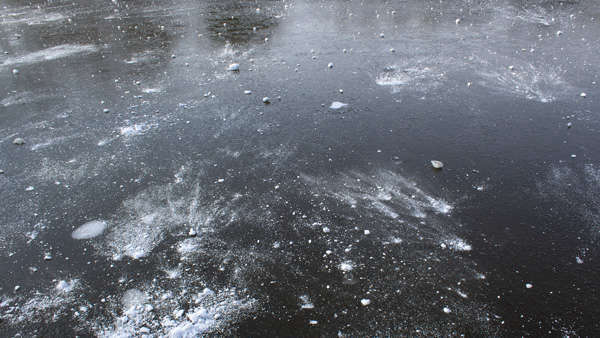
Every winter, thousands of Hoosiers safely enjoy fishing, skating, hiking, or just sliding around on frozen ponds and lakes. And every year, people drown after falling through ice.
Don’t let this happen to you or anyone around you.
Indiana Conservation Officers remind Hoosiers to be careful as they begin to partake in activities such as ice fishing, ice skating, or snowmobiling. Remember to put safety first. Take caution when going on frozen lakes, ponds, rivers, streams, and retention ponds. And watch for others who may venture out on frozen waterways and find themselves in trouble.
Similar to needing to drive differently on snowy versus clear roads, safely having fun on ice may require you to adjust from what you have done in the past. The rule of thumb is to believe all ice is thin ice unless proven otherwise.
Here are a few tips to remember when considering standing on or walking on a frozen body of water:
- Assume no ice is safe ice.
- Test the thickness of the ice with an ice auger. At least 4 inches is recommended for ice fishing; 5 inches is recommended for snowmobiling.
- If you don’t know the thickness of the ice, don’t go on it.
- Wear a life jacket or flotation coat.
- Carry ice picks and rope gear.
- Before going on the ice, leave a note of your whereabouts with a friend or family member.
- Don’t test the thickness of the ice while alone.
Wearing a life jacket is especially important when on ice. If you fall through, a life jacket will keep your head above the water until help arrives.
Remember that a new coating of snow, while perhaps beautiful, can make for treacherous ice conditions. Snow can serve as insulation, causing water to freeze at a slower rate. When snow and rain freeze into ice, it is not as strong as solid, clear ice.
Another potentially dangerous situation is when you see a pet or other animal in distress on the ice. If that happens, do not go after it. Instead, contact local emergency response personnel, who are equipped to make a rescue.
A few more tips:
- Some bodies of water can appear to be frozen solid but still have thin ice in several unexpected areas.
- Avoid flowing water, such as rivers and streams, when covered by a layer of ice.
- Similarly, water surrounded by sand may freeze with inconsistencies in the thickness of the ice.
- Underground springs, wind, waterfowl, and other animals can also keep areas of ice thin.


 DNR receives regional award for project on former mine land near Pleasantville
DNR receives regional award for project on former mine land near Pleasantville
 ISP shopping safety tips
ISP shopping safety tips
 Funding available for waste tire cleanup projects
Funding available for waste tire cleanup projects
 Riverton Parke's Emily Adams awarded the Lilly Endowment Community Scholarship for Parke County
Riverton Parke's Emily Adams awarded the Lilly Endowment Community Scholarship for Parke County
 BMV announces Christmas and New Year's Day holiday hours
BMV announces Christmas and New Year's Day holiday hours
 Indiana launches Smart SNAP
Indiana launches Smart SNAP
 Indiana 211: Connecting Hoosiers to holiday support and essential resources
Indiana 211: Connecting Hoosiers to holiday support and essential resources
 Department of Homeland Security launches Worst of the Worst website
Department of Homeland Security launches Worst of the Worst website
 Governor Braun takes action to waive hours-of-service regulations for transporting propane
Governor Braun takes action to waive hours-of-service regulations for transporting propane
 Two Indiana State Fair Commission executives elected to prominent national IAFE Positions, Indiana State Fair honored with multiple awards
Two Indiana State Fair Commission executives elected to prominent national IAFE Positions, Indiana State Fair honored with multiple awards
 Cover Crop Premium Discount Program available for Hoosier farmers, new pre-enrollment available
Cover Crop Premium Discount Program available for Hoosier farmers, new pre-enrollment available
 Indiana FSSA extends open enrollment for HIP and PathWays Plans through December 24
Indiana FSSA extends open enrollment for HIP and PathWays Plans through December 24
 Consumer Alert: Dozens of dangerous products recalled in November
Consumer Alert: Dozens of dangerous products recalled in November
 Connect with Indiana 211 to find local warming centers during the winter weather season
Connect with Indiana 211 to find local warming centers during the winter weather season
 Car crash claims Greencastle life
Car crash claims Greencastle life
 Rockville Police add Drug Terminator to their arsenal
Rockville Police add Drug Terminator to their arsenal
 Man arrested on battery charges after fleeing scene, officers
Man arrested on battery charges after fleeing scene, officers
 Cayuga man arrested for child seduction
Cayuga man arrested for child seduction
 Veterinary bill passes out of committee
Veterinary bill passes out of committee



